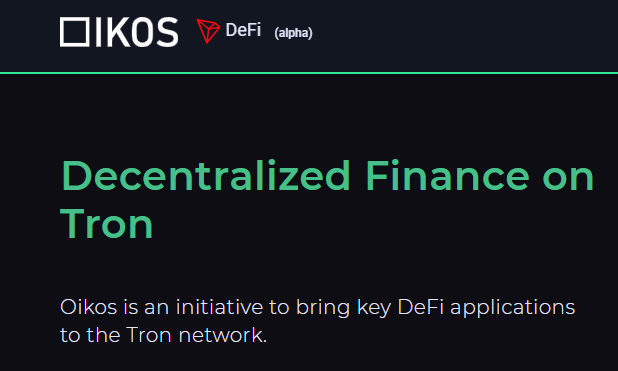HOW OIKOS IS DECENTRALIZING SYNTHETIC ASSETS

Oikos wants to reposition the trading of Synthetic Assets (Synths) using the Tron blockchain network. The platform is putting machinery in place to ensure that Decentralized Financing (DeFi) structures are infused into the new model of trading Synthetic Assets.
COLLATERALIZATION
Oikos has a dedicated crypto token called Oikos Network Tokens (OKS). It is these tokens that will be used as collaterals by the holders who will stake the same so they can mint Synthetic Assets.
Minter is the name of the decentralized application (DApp) that will be used for facilitating Synths minting, as well as allowing the users to stake their OKS.
The idea is that the OKS holders cum stakers tend to incur debts anytime they are minting Synthetic Assets. Before they can exit the system or unlock their locked OKS, they would have to pay off the debt they owe. The debt is payable by burning Synthetic Assets (Synths).
On the other hand, you may want to take the “shorter route” of leveraging the use of the Oikos Network Tokens (OKS) as alternative collateral. In this case, OKS’ trailing to Tronix Token (TRX) paves the way for the seamless borrowing of Synthetic Assets (Synths) against the Tronix Token (TRX).
DEFI EXCHANGE
Decentralized Finance (DeFi) isn’t all about trading on cryptocurrencies and other digital assets. It also extends to the use of other parameters to facilitate decentralized transactions.
Oikos does a great job here by enabling the use of its dedicated cryptocurrency exchange that will operate in a Decentralized Finance (DeFi) model.
There are many reasons why potential investors are thrilled to leverage the DeFi Oikos exchange. Below are some of them:
Peer Trading
The first feature of the Oikos exchange is that trades can be executed without using order books. The idea here is to remove the hiccups that are tenable in the traditional/centralized exchanges and Decentralized Exchanges (DEXs) based on order books.
The difference that the Oikos exchange makes in the entire equation is that it allows for Peer-to-Contract (P2C) trading by replacing the order book with the execution of trades against the contract.Trustless
At a time like this that blockchain technology is looked upon as the network that fosters decentralization, the trust must be retained.
In light of that, Oikos evolves to become a trustless exchange that allows the users to trade any crypto token that is based on the Tron network without having to make deposits or withdrawals to a centralized order book.
The trustless undertone to the Oikos exchange is made possible by the basis of the Oikos Swap, which is a Tron port of Uniswap.Price Feeds
The market is constantly monitored to check the direction. That is why Oikos uses multiple trusted sources to aggregate price data. The derived data will then be used to create a robust price oracle mechanism.
Afterwards, the price oracle mechanism will help in assigning an exchange rate to the assets in view.
Final Thoughts
Oikos’ goal is to decentralize how Synthetic Assets (Synths) are traded. Leveraging the Tron blockchain network and delegating price feeds to monitor the market are sure ways of monitoring and facilitating the full-scale decentralization of the Synthetic Assets (Synths) market.
USEFUL LINKS
Website: https://oikos.cash/
Medium: https://medium.com/@oikoscash
Bitcointalk: https://bitcointalk.org/index.php?topic=5243484.0
Github: http://github.com/oikos-cash
Telegram: http://t.me/oikoscash
Twitter: http://twitter.com/oikos_cash
Discord: http://discord.gg/qjuqy6X
Litepaper: https://docs.oikos.cash/litepaper/
AUTHORS DETAILS
Bitcointalk Username: Gopalwu
Bitcointalk Profile Link: https://bitcointalk.org/index.php?action=profile;u=2759913;sa=summary